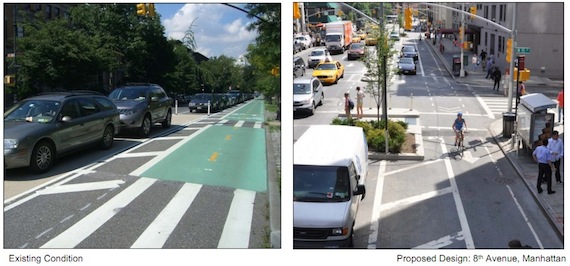
The city has released its final findings on the redesign of Prospect Park West [PDF]. With the data showing it a success by most any objective measure, DOT is recommending a few tweaks to further improve the design.
The proposed modifications should make the new Prospect Park West even friendlier to pedestrians. At intersections, the tan paint marking the pedestrian zone of the median will be replaced with raised islands. That should keep parked cars from intruding on pedestrian space. Along the bike path, DOT wants to install "rumble strip" markings to alert riders that they're approaching an intersection. DOT also suggests rearranging the loading zones at 9th Street and narrowing the bike lane buffer at the very northern end of Prospect Park West in order to better transition into Grand Army Plaza.
Those changes should put the finishing touches on a project that's shown huge results on the street. To review:
- Under the new design, total traffic crashes are down 16 percent.
- Even more important, crashes that cause injuries are down 63 percent.
- Under the new design, there have been no reported injuries to pedestrians, from either cars or bikes.

Prospect Park West users are so much safer in large part because traffic has been slowed down:
- Before the redesign, three in four drivers traveled over the speed limit. Now, only one in five speeds.
- The average speed on the old Prospect Park West was 33.8 mph. On the new street, the average is 26.6 mph.
But cutting down on speeding doesn't mean that Prospect Park West is mired in congestion. Just as many drivers can get where they're going, with little to no impact on travel time:
- The two-lane Prospect Park West carries 7.8 percent more motor vehicles in the morning than the three-lane configuration did. The number of cars on the road in the evening stayed the same.
- It takes essentially the same amount of time to drive the length of Prospect Park West as in the past: a few seconds longer in the morning and a few seconds shorter at midday and in the evening.
- Driving times also dropped by a few seconds on nearby Eighth and Sixth Avenues, though they increased by a few seconds on Seventh Avenue.
While the street continues to serve drivers well, it's done wonders for cyclists.
- On weekdays, the number of cyclists on the street nearly tripled, jumping 190 percent.
- On weekends, when bike traffic was already higher, the number of cyclists more than doubled, rising 125 percent.
- By serving all those new cyclists, the capacity of Prospect Park West was increased by the redesign. The street now carries 11 percent more commuters during the morning rush and six percent more during the afternoon, counting motor vehicles and bikes.
- The new lane has also empowered cyclists to ride more safely. Whereas before, just under half of all weekday cyclists rode on the sidewalk, now only three percent do so.
The facts don't lie: the Prospect Park West redesign is keeping people safe, making room for more New Yorkers to get to work, and encouraging cycling. If you support those results, you can help this project move to the next phase at tonight's Brooklyn CB 6 meeting.





